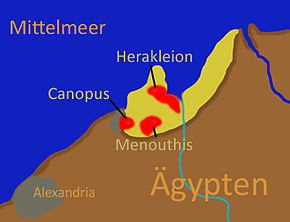Heracleion

|
|
| Location | near Alexandria, Egypt |
|---|---|
| Coordinates | 31°18′15″N 30°06′02″E / 31.30417°N 30.10056°ECoordinates: 31°18′15″N 30°06′02″E / 31.30417°N 30.10056°E |
Heracleion (Greek: Ἡράκλειον), also known as Thonis (Θῶνις), was an ancient Egyptian city located near the Canopic Mouth of the Nile, about 32km northeast of Alexandria. Its ruins are located in Abu Qir Bay, currently 2.5 km off the coast, under 10 m (30 ft) of water. Its legendary beginnings go back to as early as the 12th century BC, and it is mentioned by ancient Greek historians. Its importance grew particularly during the waning days of the Pharaohs. In the Late Period, it was Egypt's main port for international trade and collection of taxes.
Heracleion was originally built on some adjoining islands in the Nile Delta, and was intersected by canals. It had a number of harbors and anchorages and was the sister city of Naucratis until it was superseded by Alexandria.
It was believed that Paris and Helen of Troy were stranded there on their flight from the jealous Menelaus, before the Trojan war began or that Menelaus and Helen had stayed there, accommodated by the noble Egyptian Thon and Polydamna. Also, it was believed that Heracles himself had visited the city, resulting in the Greeks calling it by the Greek name Heracleion rather than its original Egyptian name Thonis.
Until very recently the site had been known only from a few literary and epigraphic sources, one of which interestingly mentions the site as an emporion, just like Naukratis.
The city was mentioned by the ancient historians Diodorus (1.19.4) and Strabo (17.1.16). Herodotus was told that Thonis was the warden of the Canopic mouth of the Nile: Thonis arrested Alexander (Paris), the son of Priam, because Alexander had abducted Helen of Troy and taken much wealth.
...
Wikipedia

